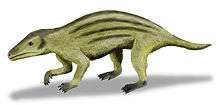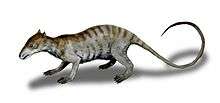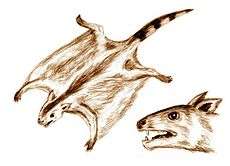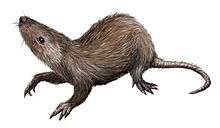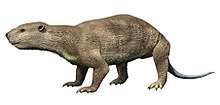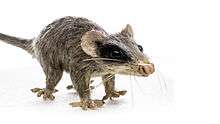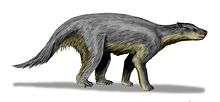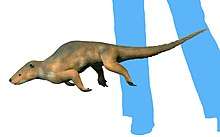Magallanodon
Magallanodon is a genus of mammals from the extinct group Gondwanatheria. It contains a single species, Magallanodon baikashkenke. The species is the first Mesozoic mammal known from Chile, and is Late Cretaceous in age. It is known from individual teeth found in a quarry in the Río de Las Chinas Valley located in the Magallanes Basin in Chilean Patagonia. The fossils come from the Dorotea Formation, which is Late Campanian to Early Maastrichtian in age.[1]
| Magallanodon | |
|---|---|
| Scientific classification | |
| Kingdom: | Animalia |
| Phylum: | Chordata |
| Clade: | Therapsida |
| Clade: | Cynodontia |
| Family: | †Ferugliotheriidae |
| Genus: | †Magallanodon Goin et al., 2020 |
| Species: | †M. baikashkenke |
| Binomial name | |
| †Magallanodon baikashkenke Goin et al., 2020 | |
Etymology
The name Magallanodon comes from the Magallanes Region in southern Chile and odontos, Greek for tooth. The species name, M. baikashkenke is taken from the Tehuelchian words bai (grandfather) and kashkenke (valley) - Grandfather's Valley is the name for the region where the fossil was first found, also called the Río de Las Chinas.[1]
References
- Goin, Francisco J.; et al. (2020). "First Mesozoic Mammal from Chile: the southernmost RECORD of a Late Cretaceous Gondwanatherian" (PDF). Boletín del Museo Nacional de Historia Natural, Chile. 69 (1): 5–31.
| ||||||||||||||||||||||||||||||||||||||||||||||||||||||||||||||||||||||||||||||||||||||||||||||||||||||
| ||||||||||||||||||||||||||||||||||||||||||||||||||||||||||||||||||||||||||||||||||||||||||||||||||||||
| ||||||||||||||||||||||||||||||||||||||||||||||||||||||||||||||||||||||||||||||||||||||||||||||||||||||
| ||||||||||||||||||||||||||||||||||||||||||||||||||||||||||||||||||||||||||||||||||||||||||||||||||||||
| ||||||||||||||||||||||||||||||||||||||||||||||||||||||||||||||||||||||||||||||||||||||||||||||||||||||
| ||||||||||||||||||||||||||||||||||||||||||||||||||||||||||||||||||||||||||||||||||||||||||||||||||||||
| ||||||||||||||||||||||||||||||||||||||||||||||||||||||||||||||||||||||||||||||||||||||||||||||||||||||
| ||||||||||||||||||||||||||||||||||||||||||||||||||||||||||||||||||||||||||||||||||||||||||||||||||||||
| Taxon identifiers |
|---|

